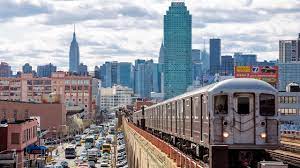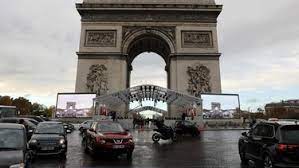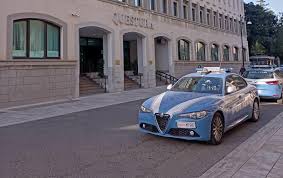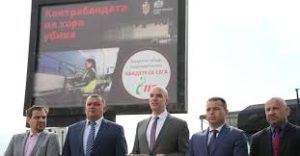The cities cutting back on cars

From London to New York: Can quitting cars be popular?
Cities around the world reveal surprising truths about getting the public on board with cutting car-use.
“There is a war against cars in America,” a popular right-wing YouTube channel declared in 2017. The short film argued that tighter emissions standards made gas-powered cars more costly, and were part of a wider push to get people out of their individual vehicles and onto public transportation. “So much for the freedom of the open road,” the video lamented.

The views raised in the video were not new, or limited to the US. Accusations of a “war” had been circulating in the UK 15 years previously, as London prepared to introduce what was then the world’s largest congestion charge scheme, requiring drivers to pay for city-centre journeys. More recently, the city’s expansion of its Ultra-Low Emission Zone (or Ulez), which also charges cars that don’t meet certain emissions standards, has seen “Blade Runner” protesters tear down enforcement cameras. In the Belgian city Ghent, the deputy mayor received death threats in the wake of a 2017 plan to discourage short journeys by car.
Despite the ongoing pushback, cities around the world are continuing efforts to reduce traffic and improve air quality by encouraging drivers to switch from polluting cars to greener transport. Paris has a target to ban gas-powered cars by 2030, citing the need to tackle climate change. And, later in 2024, New York is set to conduct a first-in-nation car-reduction experiment : the launch of a long-delayed congestion charge on journeys below Manhattan’s 60th Street.
New York City’s decision to finally go ahead with a congestion pricing plan comes after decades of blocks, both at state and national level. The initiative aims to reduce city-centre traffic by 15-20%, and to raise billions for its struggling subway system in the process. But in America’s land of the freeway – where cars have long symbolised independence and the romance of the road is part of the collective imagination – can schemes to tackle excessive car use ever gain widespread support?
Riding the car-reduction curve
The need for change in US urban centres is quite literally in the air. Tail-pipe emissions are akin to “wildfires that are happening on our own streets”, said New York’s governor Kathy Hochul in a press conference celebrating the congestion charge’s federal approval. Working hours lost sitting in traffic equate to around $20bn [£15.8bn] a year, she added; “a complete waste”.
Moreover, reforms elsewhere suggest that, despite initial resistance, car reduction plans steadily gain public acceptance in the long run. When the city of Ljubljana in Slovenia pedestrianised its city centre in 2007, opposition was considerable, with residents fearing restricted access to their homes – yet a little over decade later, roughly 90% said they were against reintroducing cars.
After more than 10 years of a car-free city centre, around 90% of residents in the city of Ljubljana, Slovenia, said they supported the pedestrianisation. (Credit: Getty Images)
After more than 10 years of a car-free city centre, around 90% of residents in the city of Ljubljana, Slovenia, said they supported the pedestrianisation. (Credit: Getty Images)
Why the early opposition? People struggle to weigh potential losses against gains. So suggests a concept in behavioural psychology known as prospect theory, with a disproportionate aversion to loss encouraging a bias towards the status quo.
This bias, in turn, can make implementing change tricky – as Birgitta Gatersleben, professor of environmental psychology at the University of Surrey, discovered when she conducted research in Guildford in the UK. “We found local businesses were very against pedestrianising the town centre,” she recalls. “They were worried they would lose customers – even though we had lots of evidence that if you pedestrianise high streets you get more.”
Showing people the benefits of car reduction, rather than just telling them, can consequently have a powerful effect. In Sweden’s Stockholm, the city’s congestion pricing programme began with a trial run in 2006, during which public opinion shifted from large opposition to small majority support. A referendum the following year gave the change a permanent green light.
“The moment before you do something is the most precarious political moment of all, because of all the fearmongering,” says Doug Gordon, a safe-streets advocate and co-host of the provocatively titled podcast War on Cars. “But, in my experience, the fears also don’t usually come to pass and the benefits do.”
CARBON COUNT
The emissions from travel it took to report this story were 0kg CO2. The digital emissions from this story are an estimated 1.2g to 3.6g CO2 per page view. Find out more about how we calculated this figure here.
There is even a curve that predicts this change in attitudes, according to Leo Murray, director of innovation at climate charity Possible. Named the “Goodwin curve” after the work of Philip Goodwin, emeritus professor of transport policy at University College London, the curve (or dip) charts how public support for road pricing schemes tend to begin well, with recognition of the need for intervention. That support then falls away as more specific details are released ahead of enforcement, only to rise again after implementation.
“We can’t find a single example of a traffic-reduction measure that’s been in place for more than two years that’s then gone on to be removed because of a lack of public support,” Murray notes, pointing to an Edinburgh study which showed initial opposition to speed limits shifting to support. He also cites Spain’s reassuring message to Wales when the latter was considering introducing speed limit change.
“But the process of getting there is painful and always follows these curves,” Murray adds. “So what is required is political courage and sensible scheduling. You don’t want to be running for re-election at the start of the Goodwin curve.”
London’s recent expansion of its Ultra-Low Emission Zone (Ulez) across all city boroughs has prompted protests (Credit: Alamy)
London’s recent expansion of its Ultra-Low Emission Zone (Ulez) across all city boroughs has prompted protests (Credit: Alamy)
What can cities considering introducing car-reduction policies learn from the successes and stumbles of those that have gone before them?
Some answers may lie in a better understanding of human behaviour and decision making, research suggests, with car-reduction interventions appearing to work best when take a multi-pronged approach to encouraging change. For example, when they simultaneously aim to change travel behaviour to more active modes, such as walking and cycling. Good communication and awareness-raising can also be key, and in 2003 London deployed an extensive and phased communications strategy, based around answering the questions people most frequently asked: “How will it affect me? How will it work?”
But such efforts can still be politically risky if not perceived to be sufficiently fair, supportive or responsive to concerns. Pushback to the Mayor of Paris, Anne Hidalgo’s, ambitious array of school streets, pedestrianisation, cycle lanes and parking restrictions, for example, has been loud. A movement called #saccageparis – translating to “ransacking Paris” – expressed fury at the transformation of the city’s streets.
The Paris metropole’s wider roll-out of a new low-emission zone is consequently taking a considered approach to change, explains Tony Renucci, executive director at Respire, a national non-profit which fights against air pollution. “They’re taking more time and trying to develop more financial aids to help people to switch cars,” he says, such as providing up to €6,000 (£5,160/£6,540) to those who scrap a highly polluting car in exchange for an electric, hydrogen or hybrid.
Will this be the first European city to ban cars?
Similarly, in London, the popularity of the city’s original congestion charge rose after it was announced that the money it raised would be ring-fenced for improvements to transport. This summer, ahead of the Ulez extension, a scrappage scheme was also expanded to financially support those switching to cleaner vehicles to all Londoners (from means-tested only).
“It is fundamentally about fairness; about ensuring it is not the most vulnerable who pay, it’s the polluter,” says Mark Watts, executive director of C40 Cities, a global network of mayors.
Watts served as a senior advisor to former mayor Ken Livingston, London’s first directly elected mayor, who oversaw the introduction of both London’s congestion charge and low-emission zone. “You’ve got to give people a genuine choice: not just make it expensive to drive, but an opportunity to switch to walking or public transport,” he explains. “Barcelona introduced free travel for three years for those who got rid of polluting cars, Stockholm expanded bus services, London, around Ulez, has offered discounts on car-clubs, bike hire and scrappage.”
And ultimately, says the War on Cars podcast’s Gordon, it might also come down to an administration’s simple determination to face down opposition. “You just have to get things done and then move forward – because there will always be controversy,” says Gordon.
New York’s congestion pricing journey
Has New York’s congestion plan learned from these experiences elsewhere? It is strengthened, notes Watts, by its plan to reinvest the toll’s revenues ($15bn/£11.9bn) back into the MTA public transit network, “which anyone who has been on recently knows it needs”.
The scheme will also operate a fluctuating charge system, with smaller fees during off-peak hours, providing flexibility. Plus a supportive coalition of grassroots organisations and big businesses, Congestion Pricing Now, has helped spread awareness – via public events, meetings with stakeholders, and hosting a big advertising campaign.
There is still resistance. “Congestion pricing scheme is just another pothole in NYC’s road to ruin,” ran a headline last year in a daily newspaper. And concern is especially high in the neighbouring state of New Jersey, where car-dependent commuters already pay a toll to enter Manhattan, with New Jersey’s state governor calling the proposal a “brazen money grab” by New York.
Yet Kate Slevin, from theRegional Plan Association, a non-profit civic organisation, suggests that there are ways to help ease these concerns. One approach could include equalising tolls, “so that, no matter how many bridges or tunnels you cross, drivers pay about the same”.
Additionally, she notes, there are already mitigation plans in place to counter the risk that truck traffic will be pushed into already-deprived areas. Truck traffic is a particular problem since these and other large vehicles have limits on the crossings they can use in and out of the city, meaning the congestion fee might encourage them to take longer routes through residential neighbourhoods. The plan thus includes $155m (£122m) of investment in reducing truck pollution, improving asthma care, expanding parks and electrifying buses.
“As traffic is reduced, it’s easier to put in pedestrian zones, protected bus and cycle lanes, and smart approaches to parking and freight management,” says Slevin. “But new approaches to streets require leadership from city officials as well, and a vision that can cut through some of the local politics that have slowed bus or bike lane installation in New York or elsewhere.”
Numerous other cities, from Boston to Oregon, are now considering following suit. The former has proposed a mobility pricing commission to explore options including congestion pricing, and the latter is already testing a more extensive system of vehicle fees based on miles travelled (VMT). “It’s a really exciting time in the history of New York – and it’s exciting for the country too,” says Slevin.
Urban policy consultant Diana Lind has even suggested that this national-first for America could help mark the start of a wider shift away from gas-powered cars. “Congestion pricing is bound to influence other cities that are trying to figure out how to support public transit and promote more sustainable mobility options, like walking and biking,” she says.
When it became clear that New York was pursuing congestion pricing in 2019, Lind notes, Philadelphia started to think about the possibility as well. And as the plan made headlines again in 2023, cities like Los Angeles started thinking about how it could apply there too. “Cities look to each other for best practices, and if New York’s programme is successful, other mayors will undoubtedly start thinking about ways to implement something similar in theirs.”
One thing we can be sure of is that those mayors will have a close eye on New York’s scheme to see, among other things, if the Goodwin curve will hold true once again.





